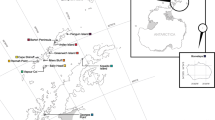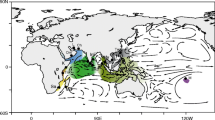Abstract
The genetic population structure of the Pacific bluefin tuna (PBF) Thunnus orientalis and the yellowfin tuna (YFT) T. albacares in the North Pacific Ocean was investigated. The polymorphism of microsatellite (SSR) loci and sequences of mitochondrial DNA control region (mtCR) were analyzed for 71 samples of PBF from Japan and Mexico and 45 samples of YFT from Japan and Panama. In the SSR analyses, both single-locus (−0.010 to 0.008 in PBF and −0.023 to 0.020 in YFT) and global multilocus (0.003 in PBF and −0.002 in YFT) F ST values among the geographic populations were low and not significant in these species. In the mtCR analyses, neither the neighbor-joining tree nor the minimum spanning network showed genetic differentiation among the geographic populations in each species. The pairwise F ST values among the geographic populations of them (−0.005 in PBF and −0.020 to −0.014 in YFT) were low and not significant. Our SSR and mtCR data suggested that genetic differentiations were not evident among the eastern and western populations in the North Pacific Ocean either in PBF or in YFT. Mismatch distributions, demographic parameters, and neutrality tests suggested that sudden population expansion of PBF and YFT in the North Pacific Ocean occurred 628,000–731,000 and 450,000–525,000 years ago, respectively.




Similar content being viewed by others
References
Collette BB, Smith BR (1981) Bluefin tuna, Thunnus thynnus orientalis, from the Gulf of Papua. Japan J Ichthyol 28:166–168
Honda N (2012) The situation connecting tuna (in Japanese). National Diet Library-Issue Brief-Number 738:1–12
Fisheries Research Agency (2013a) Pacific bluefin tuna in the Pacific Ocean (in Japanese). Present condition of international fisheries stock in 2013.:1–8
ISC Pacific bluefin tuna Working Group (2013) Scientific committee ninth regular session. Stock Assessment of Pacific Bluefin Tuna in 2012. WCPFC-SC9-2013/SA-WP-10 (Rev 1): 1–67
Collette BB, Nauen CE (1983) Scombrids of the world–an annotated and illustrated catalogue of tunas, mackerels, bonitos and related species known to date. FAO Fisher Syn no. 125(2), FAO, Rome
International Seafood Sustainability Foundation (2012) ISSF status of the world fisheries for tuna, management of tuna stocks and fisheries. ISSF Technical Report 2012–07:1–21
Inter-American Tropical Tuna Commission (2013) Tunas and billfishes in the eastern Pacific Ocean in 2012. Fishery Status Report No. 11: 1–171
Langley A, Holey S, Hampton J (2011) Scientific committee seventh regular session. Stock assessment of yellowfin tuna in the western and central Pacific Ocean. WCPFC-SC7-2011/SA-WP-03 (Rev.1-03Aug2011): 1–132
Fisheries Research Agency (2013b) Yellowfin tuna in the East Pacific Ocean (in Japanese). Present condition of international fisheries stock in 2013.:1–2
Sawada Y, Okada T, Miyashita S, Murata O, Kumai H (2005) Completion of the Pacific bluefin tuna Thunnus orientalis (Temminck et Schlegel) life cycle. Aquac Res 36:413–421
Inagake D, Yamada H, Segawa K, Okazaki M, Nitta A, Itoh T (2001) Migration of young bluefin tuna, Thunnus orientalis Temminck et Schlegel, through archival tagging experiments and its relation with oceanographic condition in the western North Pacific. Bull Nat Res Inst Far Seas Fish 38:53–81
Itoh T, Tsuji S, Nitta A (2003) Migration patterns of young Pacific bluefin tuna (Thunnus orientalis) determined with archival tags. Fish Bull 101:514–534
Schaefer KM, Fuller DW, Block BA (2007) Movements, behavior, and habitat utilization of yellowfin tuna (Thunnus albacares) in the northeastern Pacific Ocean, ascertained through archival tag data. Mar Biol 152:503–525
Sharp GD (1978) Behavioral and physiological properties of tunas and their effects on vulnerability to fishing gear. In: Sharp GD, Dizon AE (eds) The Physiological Ecology of Tunas. Academic Press, New York, pp 397–449
Ward RD, Elliott NG, Grewe PM, Smolenski AJ (1994) Allozyme and mitochondrial DNA variation in yellowfin tuna (Thunnus albacares) from the Pacific Ocean. Mar Biol 118:531–539
Ward RD, Elliott NG, Innes BH, Smolenski AJ, Grewe PM (1997) Global population structure of yellowfin tuna, Thunnus albacares, inferred from allozyme and mitochondrial DNA variation. Fish Bull 95:566–575
Scoles DR, Graves JE (1993) Genetic analysis of the population structure of yellowfin tuna, Thunnus albacares, from the Pacific Ocean. Fish Bull 91:690–698
Appleyard SA, Grewe PM, Innes BH, Ward RD (2001) Population structure of yellowfin tuna (Thunnus albacares) in the western Pacific Ocean, inferred from microsatellite loci. Mar Biol 139:383–393
Díaz-Jaimes P, Uribe-Alcocer M (2006) Spatial differentiation in the eastern Pacific yellowfin tuna revealed by microsatellite variation. Fish Sci 72:590–596
Takagi M, Okamura T, Chow S, Taniguchi N (1999) PCR primers for microsatellite loci in tuna species of the genus Thunnus and its application for population genetic study. Fish Sci 65:571–576
McDowell JR, Díaz-Jaimes P, Graves JE (2002) Isolation and characterization of seven tetranucleotide microsatellite loci from Atlantic northern bluefin tuna Thunnus thynnus thynnus. Mol Ecol Notes 2:214–216
van Oosterhout C, Hutchinson WF, Wills DPM, Shipley P (2004) Micro-checker: software for identifying and correcting genotyping errors in microsatellite data. Mol Ecol Notes 4:535–538
Guo SW, Thompson EA (1992) Performing the exact test for Hardy-Weinberg proportion for multiple alleles. Biometrics 48:361–372
Excoffier L, Lischer HEL (2010) Arlequin suite ver. 3.5: a new series of programs to perform population genetics analyses under Linux and Windows. Mol Ecol Res 10:564–567
Rice WR (1989) Analyzing tables of statistical tests. Evolution 43:223–225
Weir BS, Cockerham CC (1984) Estimating F-Statistics for the analysis of population structure. Evolution 38:1358–1370
Alvarado Bremer JR, Stequert B, Robertson NW, Ely B (1998) Genetic evidence for inter-oceanic subdivision of bigeye tuna (Thunnus obesus) populations. Mar Biol 132:547–557
Larkin MA, Blackshields G, Brown NP, Chenna R, McGettigan PA, McWilliam H, Valentin F, Wallace IM, Wilm A, Lopez R, Thompson JD, Gibson TJ, Higgins DG (2007) Clustal W and Clustal X ver. 2.0. Bioinformatics 23:2947–2948
Nei M (1987) Molecular Evolutionary Genetics. Columbia University Press, New York
Saitou N, Nei M (1987) The neighbor-joining method: a new method for reconstructing phylogenetic trees. Mol Biol Evol 4:406–425
Kimura M (1980) A simple method for estimating evolutionary rate of base substitutions through comparative studies of nucleotide sequences. J Mol Evol 16:111–120
Felsenstein J (1997) PHYLIP (Phylogeny Inference Package), ver. 3.65. University of Washington, Seattle, WA
Felsenstein J (1985) Confidence limits on phylogenies: an approach using bootstrap. Evolution 39:783–791
Clement M, Posada D, Crandall KA (2000) TCS: a computer program to estimate gene genealogies. Mol Ecol 9:1657–1659
Rogers AR (1995) Genetic evidence for a Pleistocene population explosion. Evolution 49:608–615
Harpending HC (1994) Signature of ancient population growth in a low-resolution mitochondrial DNA mismatch distribution. Hum Biol 66:591–600
Schneider S, Excoffier L (1999) Estimation of past demographic parameters from the distribution of pairwise differences when the mutation rates vary among sites: application to human mitochondrial DNA. Genetics 152:1079–1089
Rogers AR, Harpending H (1992) Population growth makes waves in the distribution of pairwise genetic differences. Mol Biol Evol 9:552–569
Tajima F (1989) Statistical method for testing the neutral mutation hypothesis by DNA polymorphism. Genetics 123:585–595
Tajima F (1989) The effect of change in population size on DNA polymorphism. Genetics 123:597–601
Fu Y-X (1997) Statistical tests of neutrality of mutations against population growth, hitchhiking and background selection. Genetics 147:915–925
Carlsson J, McDowell JR, Díaz-Jaimes P, Carlsson JEL, Boles SB, Gold JR, Graves JE (2004) Microsatellite and mitochondrial DNA analyses of Atlantic bluefin tuna (Thunnus thynnus thynnus) population structure in the Mediterranean Sea. Mol Ecol 13:3345–3356
Alvarado Bremer JR, Viñas J, Mejuto J, Ely B, Pla C (2005) Comparative phylogeography of Atlantic bluefin tuna and swordfish: the combined effects of vicariance, secondary contact, introgression, and population expansion on the regional phylogenies of two highly migratory pelagic fishes. Mol Phylogenet Evol 36:169–187
Ely B, Viñas J, Alvarado Bremer JR, Black D, Lucas L, Covello K, Labrie AV, Thelen E (2005) Consequences of the historical demography on the global population structure of two highly migratory cosmopolitan marine fishes: the yellowfin tuna (Thunnus albacares) and the skipjack tuna (Katsuwonus pelamis). BMC Evol Biol 5:19
Wu GC-C, Chiang H-C, Chou Y-W, Wong Z-R, Hsu C–C, Chen C-Y, Yang H-Y (2010) Phylogeography of yellowfin tuna (Thunnus albacares) in the Western Pacific and the Western Indian Oceans inferred from mitochondria DNA. Fish Res 105:248–253
Ramos-Onsins SE, Rozas J (2002) Statistical properties of new neutrality tests against population growth. Mol Biol Evol 19:2092–2100
Slatkin M, Hudson RR (1991) Pairwise comparisons of mitochondrial DNA sequences in stable and exponentially growing populations. Genetics 129:555–562
Maslin, M. A. and A. J. Ridgwell (2005) Mid-Pleistocene revolution and the ‘eccentricity myth’. In: Head MJ, Gibbard PL (eds) Early-Middle Pleistocene Transitions: The Land-Ocean Evidence. Geological Society, London, Special Publication, 247, pp 19–34
Huybers P (2006) Early Pleistocene glacial cycles and the integrated summer isolation forcing. Science 313:508–511
Frankham R (1996) Relationship of genetic variation to population size in wildlife. Conservation Biol 10:1500–1508
International Commission for the conservation of Atlantic tunas (2012) Report of the standing committee on research and statistics (SCRS). PLE-104/2012: 1–300
Fisheries Research Agency (2011) Yellowfin tuna in the western and central Pacific Ocean (in Japanese). Present condition of international fisheries stock in 2011:1–2
Schaefer KM (1998) Reproductive biology of yellowfin tuna (Thunnus albacares) in the eastern Pacific Ocean. Inter-Am Trop Tuna Comm, Bull 21:201–272
Margulies D, Suter JM, Hunt SL, Olson RJ, Scholey VP, Wexler JB, Nakazawa A (2007) Spawning and early development of captive yellowfin tuna (Thunnus albacares). Fish Bull 105:249–265
Acknowledgments
We thank Mr. Ryuichi Kojima at the Tsukiji Market, Tokyo, Japan, Mr. Seiji Sakamoto at the Osaka Municipal Wholesale Market Honjo, Osaka, Japan, Mr. Asanari Gima in Nanjo-city, Okinawa Pref., Japan, Mr. Yousuke Matsumoto and Dr. Rui Matsumoto at Okinawa Churaumi Aquarium, Japan, and Ms. Susana Cusatti at IATTC, USA for their help in collecting the samples of the Pacific bluefin tuna and the yellowfin tuna. This research was supported in part by a Grant-in-Aid for the SATREPS program in Japan.
Author information
Authors and Affiliations
Corresponding author
Rights and permissions
About this article
Cite this article
Nomura, S., Kobayashi, T., Agawa, Y. et al. Genetic population structure of the Pacific bluefin tuna Thunnus orientalis and the yellowfin tuna Thunnus albacares in the North Pacific Ocean. Fish Sci 80, 1193–1204 (2014). https://doi.org/10.1007/s12562-014-0789-8
Received:
Accepted:
Published:
Issue Date:
DOI: https://doi.org/10.1007/s12562-014-0789-8




